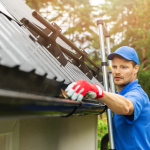
Roof Washing Services: All You Need To Know
August 21, 2024
How Often Do You Need to Clean Your Gutters?
January 26, 2025When faced with a roofing repair emergency, it’s easy to feel overwhelmed. But knowing the steps to take and whom to call can make all the difference. In addition to causing immediate inconveniences, ignoring roof damage can lead to severe consequences over time, such as escalating repair costs, long-term structural deterioration, and potential safety hazards.
There is nothing more alarming than encountering a roof emergency situation when you least expect it. The chances are that your roof has severely been battered due to heavy rain or even a hailstorm. Your shingles may have ended up displaced or missing, and the entire household starts to experience roof leaks. Not only will these problems damage your house parts, but they can also compromise the structural integrity of your entire property. This is why you must take prompt action and hire a professional rain or hail roof repair in Charlotte, NC.
In this article, we’ll cover different types of roofing emergencies and what steps to take when your roof needs emergency repair:
Types of Roofing Emergencies
Let’s first discuss what is involved in a roof emergency. Of course, this varies from one case to another, depending on the causes and severity. However, most roofing experts consider a roof emergency as having enough damage to the roof structure and an ample amount of water leaks inside your home. Below are some specific situations:
- A collapse in the roof’s structure
- The shingles, flashings, or decks are severely battered, displaced, or gone missing
- A tree limb or other debris penetrating the roofing system
- Roof devastation brought by a fire
- Visible roof damage brought by a lightning strike
- A small leak that quickly escalates to standing water
Different types of roofing emergencies stem from varying causes and can lead to severe issues. For example, roofs in Charlotte, NC, are particularly vulnerable to intense weather events like hail storms damage repair, and hurricanes, which often result in blown-off shingles or broken tiles. Snow accumulation, too, can place significant stress on a roof, leading to sagging or even structural collapse in extreme cases. Understanding the causes of these issues, such as high wind speeds, debris impacts, and moisture infiltration, can help homeowners identify and address vulnerabilities early on.
A significant structural concern is a collapse. Whether triggered by accumulated snow, heavy rainfall, or an overloaded roof deck, collapses are dangerous and require immediate evacuation. Hail damage, on the other hand, is more subtle yet pervasive, as hail can crack shingles and create small holes that allow water to penetrate gradually. Similarly, high winds can cause flashing to loosen and expose roof seams, leading to future leaks.
Immediate Steps to Take in a Roofing Emergency
When disaster strikes, immediate action is crucial. The first step should always be to ensure the safety of all household members. If there is an active storm or ongoing leaks, move your family to a safer area. For minor leaks, placing a bucket or container under the leak can help reduce water damage to floors and walls.
Securing any exposed areas is another essential measure to minimize damage. If it’s safe to do so, use tarps, plywood, or other weather-resistant materials to cover damaged sections temporarily. This action can take you time until professional help arrives, preventing further water infiltration and avoiding mold growth inside your home.
1. Take prompt actions
As soon as you encounter roof damage in Charlotte NC, you must take action as quickly as possible. Of course, how you respond depends on the type of situation you’re in. For instance, if you have rainwater leaks coming from the ceiling, you need to get a bucket to catch the water so that it doesn’t spread throughout the house. If the roof has completely been removed due to a heavy storm, you need to vacate your home immediately. Ultimately, taking prompt actions can make a difference in ensuring you and your family’s safety.
2. DIY Temporary Fixes and Precautions
Although roofing repairs are best left to professionals, there are certain temporary measures you can undertake while waiting for the experts. However, it’s essential to approach DIY repairs with caution, as improperly executed fixes can exacerbate damage.
- Shingle Patching: If you notice a few damaged or missing shingles, you can replace them temporarily with spare ones. Carefully apply roofing adhesive to hold the shingles in place. This fix isn’t long-lasting but can prevent further exposure.
- Gutter Clearance: Clogged gutters can contribute to leaks by preventing proper drainage. If it’s safe to access your gutters, clear them of any debris that may block water flow.
- Temporary Tarping: In the event of a severe leak, a heavy-duty tarp can provide temporary coverage over damaged areas. Lay the tarp as flat as possible, securing it with weights or ropes to prevent wind from lifting it.
These DIY fixes are only meant for temporary relief. Homeowners should avoid complex repairs without proper equipment, especially when working on elevated surfaces.
3. Hire a professional service repair
Although it may be tempting to handle repairs independently, professional intervention is indispensable. Roofers have specialized equipment and the expertise to diagnose hidden damage, such as compromised flashing, weakened decking, and unseen moisture buildup. They can evaluate the full extent of the damage and take comprehensive measures to restore the roof’s integrity.
Professional roofers also have access to high-quality materials that provide a durable, long-term solution. They use industry-grade adhesives, shingles, and flashing that can withstand extreme weather, offering a superior level of protection compared to temporary DIY materials.
Preventive Maintenance to Avoid Future Emergencies
While emergency repairs are crucial, preventive roof maintenance can often minimize the need for them. Regular inspections allow roofers to spot early signs of wear, such as hairline cracks in shingles or rusted flashing, which can be addressed before they escalate into major issues. In areas prone to severe weather, semi-annual inspections are ideal, especially before and after peak storm seasons. Maintenance tasks, like gutter cleaning and debris removal, also play a role in preventing emergencies by ensuring that water flows freely away from the roof’s surface.
If you live in an area with a high risk of severe weather, consider investing in impact-resistant roofing materials. These options, though more costly initially, provide an additional layer of protection against damage caused by hail or debris, potentially reducing repair costs over the long term.
Contact Charlotte Roofing Specialists For an Emergency Repair
Encountering a roofing emergency is stressful, but by knowing the appropriate steps to take, you can prevent further damage and ensure the safety of your household. From understanding the types of roofing emergencies to carrying out basic temporary fixes and reaching out to professionals, these actions can mitigate potential risks and keep your property protected.
Are you in need of emergency roof repair in Charlotte, NC? We’ve got you covered! Our team specializes in comprehensive emergency roof repair and maintenance. Reach out to us today for a free estimate and let our experienced professionals restore the safety and stability of your home. Whether it’s hail damage, storm-related leaks, or structural concerns, we’re here to provide reliable solutions that bring peace of mind.





